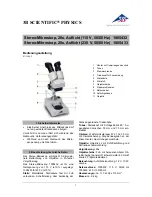Reviews:
No comments
Related manuals for Axioskop 2 plus

DMLS
Brand: Leica Pages: 160

EduLed Series
Brand: BMS Pages: 7

320
Brand: Levenhuk Pages: 50

Stellar 1 Pro-T
Brand: Swift Pages: 28

Sigma
Brand: Labomed Pages: 20

EXM-150 SERIES
Brand: Accu-Scope Pages: 14

1005432
Brand: 3B SCIENTIFIC PHYSICS Pages: 12

MIC-D
Brand: Olympus Pages: 28

3025 Series
Brand: Accu-Scope Pages: 6

A13.2604-A
Brand: OPTO-EDU Pages: 11

A41.1903
Brand: OPTO-EDU Pages: 14

A33.1502
Brand: OPTO-EDU Pages: 15

A23.1502 Series
Brand: OPTO-EDU Pages: 14

A22 3660N Series
Brand: OPTO-EDU Pages: 13

A41.1950
Brand: OPTO-EDU Pages: 23

















